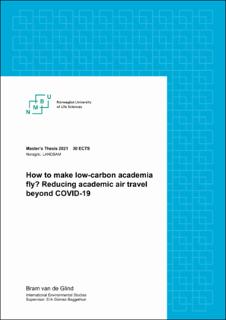| dc.description.abstract | This article seeks to advance our understanding of the underlying reasons that sustain high levels of academic flying, and explores how a low carbon academia with less academic air travel might come about. Data from thirty interviews with academics showed that internationalization, networking, improving research, and ideals of a productive academic stand amongst the strongest drivers of academic flying. These drivers come forth from underlying objectives such as pursuing excellence in research and working towards productive and successful careers. Findings from this research suggests that institutional and cultural change are prerequisites to mainstream the practical alternatives to academic flying that are at hand, such as wider use of digital communication tools, alternative modes of transport, and low-carbon conferences and meetings. We see a role for universities, grant-providing authorities and other academic organisations to include environmental standards and criteria in internationalization strategies, the concept of excellence, and funding evaluation processes. From our analysis of academics’ experiences during the COVID-19 pandemic we identify three factors that appear essential in determining whether digital communication tools can substitute physical presence; (1) the type of interaction that is desired, (2) the type of social relations that are existing among participants, and (3) the number of people who participate. Reporting on these factors can point out in which cases flying can be substituted by digital communication. Finally, we discuss whether and to which extent voluntary guidelines, the adoption of digital tools, and other soft measures will lead to cuts in academic flying at the scale and pace required for meeting climate targets, suggesting that strict limits on academic air travel might be unavoidable. | en_US |

